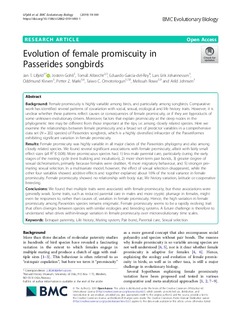| dc.contributor.author | Lifjeld, Jan Terje | |
| dc.contributor.author | Gohli, Jostein | |
| dc.contributor.author | Albrecht, Tomas | |
| dc.contributor.author | Garcia-del-Rey, Eduardo | |
| dc.contributor.author | Johannessen, Lars Erik | |
| dc.contributor.author | Kleven, Oddmund | |
| dc.contributor.author | Marki, Petter Z. | |
| dc.contributor.author | Omotoriogun, Taiwo Crossby | |
| dc.contributor.author | Rowe, Melissah | |
| dc.contributor.author | Johnsen, Arild | |
| dc.date.accessioned | 2019-08-21T12:01:04Z | |
| dc.date.available | 2019-08-21T12:01:04Z | |
| dc.date.created | 2019-08-20T10:53:03Z | |
| dc.date.issued | 2019 | |
| dc.identifier.issn | 1471-2148 | |
| dc.identifier.uri | http://hdl.handle.net/11250/2609535 | |
| dc.description.abstract | Background: Female promiscuity is highly variable among birds, and particularly among songbirds. Comparative work has identified several patterns of covariation with social, sexual, ecological and life history traits. However, it is unclear whether these patterns reflect causes or consequences of female promiscuity, or if they are byproducts of some unknown evolutionary drivers. Moreover, factors that explain promiscuity at the deep nodes in the phylogenetic tree may be different from those important at the tips, i.e. among closely related species. Here we examine the relationships between female promiscuity and a broad set of predictor variables in a comprehensive data set (N = 202 species) of Passerides songbirds, which is a highly diversified infraorder of the Passeriformes exhibiting significant variation in female promiscuity. Results: Female promiscuity was highly variable in all major clades of the Passerides phylogeny and also among closely related species. We found several significant associations with female promiscuity, albeit with fairly small effect sizes (all R2 ≤ 0.08). More promiscuous species had: 1) less male parental care, particularly during the early stages of the nesting cycle (nest building and incubation), 2) more short-term pair bonds, 3) greater degree of sexual dichromatism, primarily because females were drabber, 4) more migratory behaviour, and 5) stronger premating sexual selection. In a multivariate model, however, the effect of sexual selection disappeared, while the other four variables showed additive effects and together explained about 16% of the total variance in female promiscuity. Female promiscuity showed no relationship with body size, life history variation, latitude or cooperative breeding. Conclusions: We found that multiple traits were associated with female promiscuity, but these associations were generally weak. Some traits, such as reduced parental care in males and more cryptic plumage in females, might even be responses to, rather than causes of, variation in female promiscuity. Hence, the high variation in female promiscuity among Passerides species remains enigmatic. Female promiscuity seems to be a rapidly evolving trait that often diverges between species with similar ecologies and breeding systems. A future challenge is therefore to understand what drives within-lineage variation in female promiscuity over microevolutionary time scales. Keywords: Extrapair paternity, Life history, Mating system, Pair bond, Parental care, Sexual selection | nb_NO |
| dc.language.iso | eng | nb_NO |
| dc.rights | Navngivelse 4.0 Internasjonal | * |
| dc.rights.uri | http://creativecommons.org/licenses/by/4.0/deed.no | * |
| dc.subject | Extrapair paternity | nb_NO |
| dc.subject | Life history | nb_NO |
| dc.subject | Mating system | nb_NO |
| dc.subject | Pair bond | nb_NO |
| dc.subject | Parental care | nb_NO |
| dc.subject | Sexual selection | nb_NO |
| dc.title | Evolution of female promiscuity in Passerides songbirds | nb_NO |
| dc.type | Journal article | nb_NO |
| dc.type | Peer reviewed | nb_NO |
| dc.description.version | publishedVersion | nb_NO |
| dc.rights.holder | © The Author(s). 2019 | nb_NO |
| dc.subject.nsi | VDP::Zoologiske og botaniske fag: 480 | nb_NO |
| dc.subject.nsi | VDP::Zoology and botany: 480 | nb_NO |
| dc.source.volume | 19 | nb_NO |
| dc.source.journal | BMC Evolutionary Biology | nb_NO |
| dc.identifier.doi | 10.1186/s12862-019-1493-1 | |
| dc.identifier.cristin | 1717311 | |
| dc.relation.project | Andre: Danish National Research Foundation (no. DNRF96) | nb_NO |
| dc.relation.project | Norges forskningsråd: 230434 | nb_NO |
| dc.relation.project | Andre: Czech Science Foundation (no. 17-24782S) | nb_NO |
| dc.relation.project | Norges forskningsråd: 213592 | nb_NO |
| dc.relation.project | Norges forskningsråd: 170853 | nb_NO |
| dc.relation.project | Norges forskningsråd: 196554 | nb_NO |
| cristin.unitcode | 7511,2,0,0 | |
| cristin.unitname | Avdeling for terrestrisk økologi | |
| cristin.ispublished | true | |
| cristin.fulltext | original | |
| cristin.qualitycode | 2 | |

